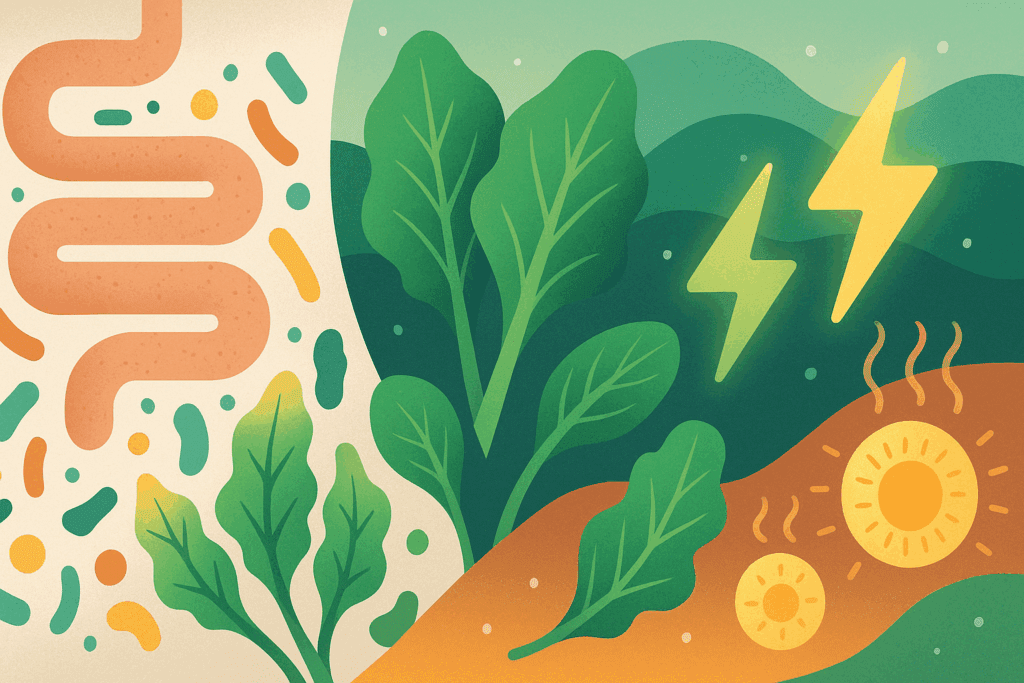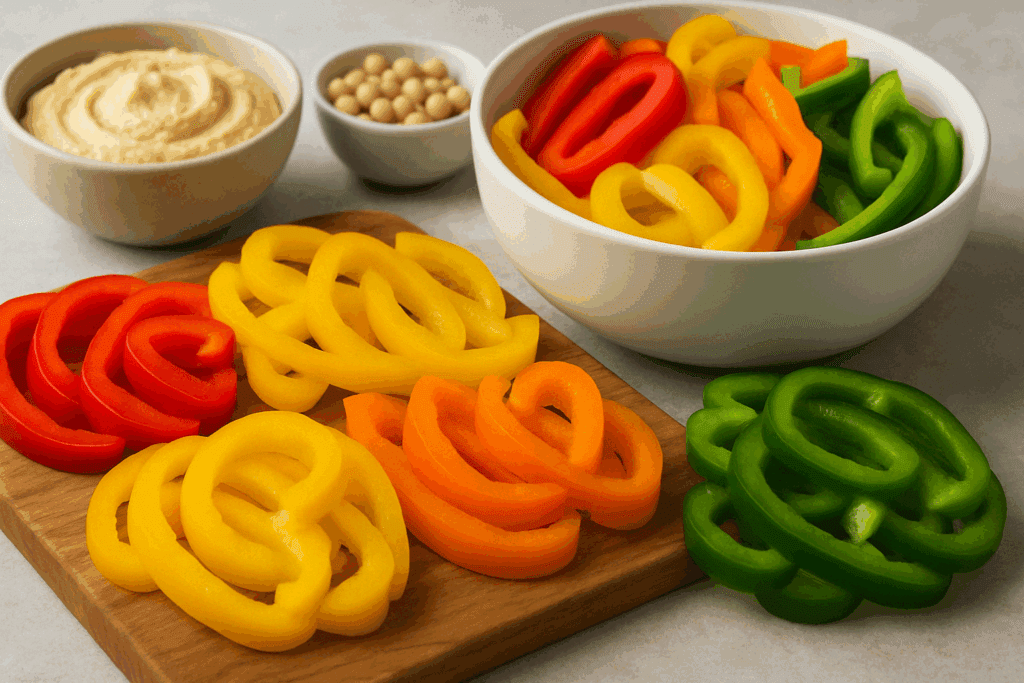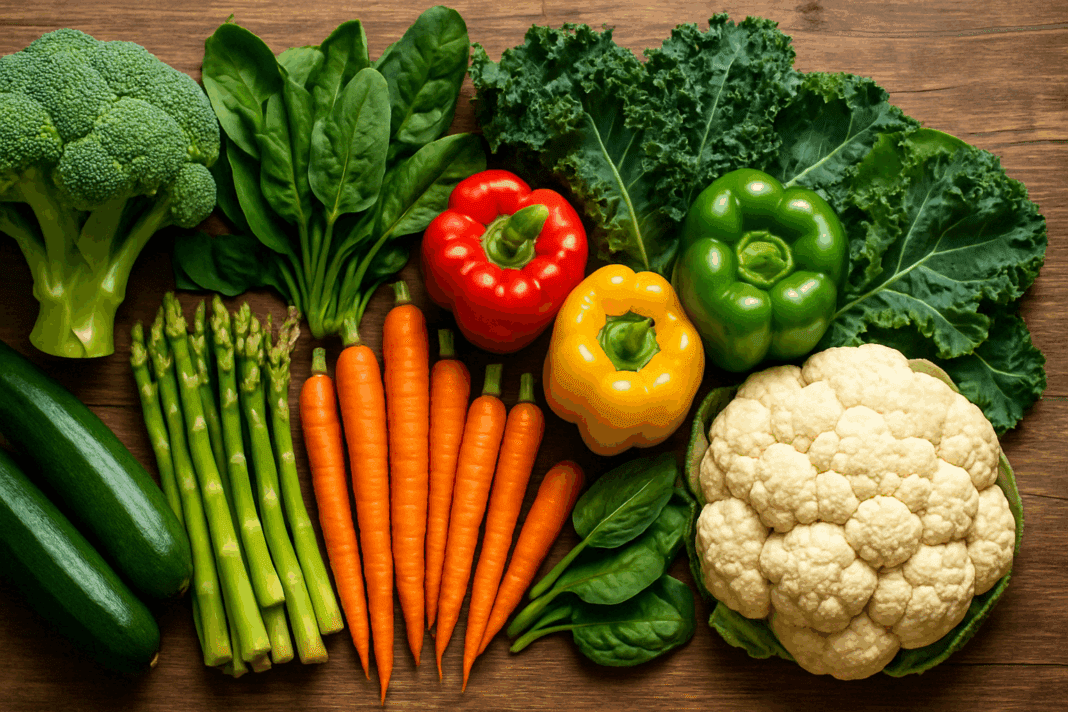A Whole-Food Plant-Based Approach to Belly Fat Reduction
For those looking to slim down, reduce visceral fat, and improve metabolic health, vegetables have long been heralded as a cornerstone of any weight loss strategy. Yet not all vegetables are created equal when it comes to promoting fat loss. Some vegetables, particularly low-fat veggies high in fiber and phytonutrients, play a more potent role in supporting weight reduction. These are not just healthy vegetables for weight loss in general—they’re scientifically supported as the healthiest vegetables for losing weight and targeting stubborn belly fat.
You may also like: Plant Based Diet vs Standard American Diet: What the Latest Studies Reveal About Long-Term Health Outcomes
This article explores ten such fat loss vegetables, delving into the mechanisms that make them effective for reducing abdominal fat. The content is grounded in nutritional science, prioritizing accuracy, clarity, and practical relevance for readers seeking a sustainable, whole-food plant-based solution to weight management. Whether you’re following a vegetable diet for weight loss or simply looking to incorporate more veggies that burn belly fat, this comprehensive guide offers expert-backed insights tailored to your goals.
Understanding the Science Behind Vegetable-Based Fat Loss
To appreciate how vegetables support fat loss, we must first examine the biological mechanisms that govern weight regulation. The body stores excess calories as fat, particularly around the abdominal area, when caloric intake exceeds expenditure. While no single food can eliminate belly fat on its own, certain vegetables possess properties that can influence fat metabolism, hormone balance, and satiety—factors that collectively contribute to weight reduction.
Fiber-rich vegetables, for instance, promote satiety by slowing digestion and reducing overall calorie intake. Many of these low-fat veggies also have a low glycemic load, which helps maintain stable blood glucose and insulin levels—crucial for preventing fat storage. Additionally, some veggies contain bioactive compounds that enhance thermogenesis, improve gut microbiota diversity, and reduce inflammation, all of which play a role in long-term weight management.
Scientific studies continue to support the idea that a vegetable diet for weight loss, when based on nutrient-dense, high-fiber options, can lead to significant improvements in body composition. From cruciferous vegetables that activate detoxification pathways to leafy greens that optimize gut health, the diversity of fat loss vegetables offers a powerful nutritional toolkit for those seeking to improve both their weight and overall well-being.

Broccoli: A Cruciferous Powerhouse for Fat Reduction
Broccoli consistently ranks among the healthiest vegetables for weight loss due to its potent combination of fiber, antioxidants, and phytochemicals. It’s low in calories yet high in volume, making it a perfect choice for promoting satiety without increasing energy intake. Rich in sulforaphane, a bioactive compound with anti-inflammatory properties, broccoli may also help mitigate metabolic inflammation—a known contributor to obesity and insulin resistance.
Clinical evidence supports broccoli’s role in belly fat reduction. A study published in the Journal of the Academy of Nutrition and Dietetics found that individuals who consumed higher amounts of cruciferous vegetables like broccoli experienced significantly lower levels of visceral fat. This suggests that incorporating broccoli into a vegetable diet for weight loss may not only help with general fat reduction but also target harmful belly fat specifically.
Broccoli also supports detoxification through its glucosinolate content, which aids liver function and hormonal balance. By improving the body’s ability to process and eliminate toxins, broccoli may indirectly support fat metabolism. Its versatility makes it easy to include in stir-fries, roasted dishes, or blended into soups, offering a flavorful and functional approach to plant-based fat loss.

Spinach: Nutrient Density Meets Appetite Control
Spinach is a quintessential example of low-fat veggies that burn belly fat through their exceptional nutrient profile and appetite-regulating properties. It contains thylakoids—plant membrane extracts that have been shown to delay fat digestion and enhance the release of satiety hormones. When consumed regularly, spinach may help reduce food intake, which is a critical factor in sustainable weight loss.
In addition to being one of the best veg for weight loss due to its low-calorie content, spinach is also rich in iron, magnesium, folate, and vitamin K. These micronutrients are essential for maintaining metabolic health, especially in individuals following a restrictive or calorie-reduced eating plan. Unlike processed diet foods that can leave the body nutrient-deprived, spinach delivers dense nutrition that supports energy and hormonal function.
Research published in Appetite demonstrates that regular consumption of spinach extract can lead to significant reductions in cravings for sweet and fatty foods. This effect is particularly valuable for those targeting belly fat reduction, as sugar and trans fats are strongly associated with increased central adiposity. By helping control these cravings, spinach becomes more than just a green leafy vegetable—it becomes a strategic tool for long-term weight management.
Kale: The Fat-Fighting Leafy Green
Another green vegetable that deserves recognition among the healthiest vegetables for losing weight is kale. Often labeled a superfood, kale is a cruciferous green loaded with fiber, antioxidants, and anti-inflammatory compounds. It’s also one of the top belly fat reduction vegetables due to its ability to improve digestive function and support detoxification processes.
Kale is particularly high in vitamin C, which plays a role in fat oxidation. Research from the American Journal of Clinical Nutrition indicates that individuals with adequate vitamin C levels oxidize 30% more fat during moderate exercise than those who are deficient. Including kale in a vegetable diet for weight loss may therefore enhance the effectiveness of physical activity by optimizing fat-burning capacity.
In terms of practicality, kale is highly versatile. It can be massaged into salads, added to smoothies, or sautéed with garlic and olive oil for a nutrient-dense side dish. Its unique texture and flavor profile make it easy to incorporate into daily meals, ensuring that the nutritional benefits are both accessible and enjoyable. For those focused on fat loss, kale’s contribution to metabolic health and satiety is both clinically supported and practically significant.

Bell Peppers: Vibrant, Crunchy, and Calorie-Conscious
Bell peppers stand out among veggies that kill stomach fat due to their high water content, low calorie count, and robust antioxidant profile. One cup of chopped bell pepper contains less than 50 calories but delivers a generous dose of vitamin C, B6, and carotenoids—nutrients that support cellular metabolism and reduce oxidative stress.
Among the most compelling aspects of bell peppers is their role in increasing thermogenesis. Capsaicin, the compound responsible for the spiciness in hot peppers, is present in smaller amounts in bell peppers and has been shown to increase energy expenditure and fat oxidation. Although milder, bell peppers still contribute to this effect without the intense heat, making them ideal for individuals who prefer a less spicy diet.
Because they are both satisfying and hydrating, bell peppers serve as a strategic snack for those trying to cut back on high-calorie, processed foods. When consumed raw with hummus or roasted as a dinner side, they help curb hunger without contributing to fat accumulation. Their combination of crunch, flavor, and low energy density makes them one of the healthiest vegetables for weight loss in both clinical and practical terms.

Zucchini: A Hydrating Option for Appetite Management
Zucchini is a moisture-rich, low-fat vegetable that excels at creating volume in meals without adding excessive calories. Its mild flavor and high water content make it ideal for extending the bulk of dishes like stir-fries, pastas, and stews, allowing for larger portions that promote satiety and satisfaction without calorie overload.
As one of the best veg for weight loss, zucchini’s high fiber content slows digestion, moderates blood sugar, and supports regular bowel function—all of which contribute to efficient fat metabolism. The soluble fiber in zucchini also feeds gut microbiota, which emerging research has linked to improved weight regulation and reduced abdominal fat.
Its potassium and manganese content supports fluid balance and metabolic enzyme function, reinforcing zucchini’s place among vegetables that burn stomach fat. Whether spiralized into noodles, grilled on skewers, or blended into soups, zucchini’s adaptability makes it a reliable and beneficial choice for anyone pursuing a vegetable-based approach to weight loss.
Cauliflower: Versatile, Filling, and Nutrient-Packed
Cauliflower is a standout among low fat veggies not just for its nutritional density but also for its culinary versatility. As a cruciferous vegetable, it shares many of the same belly fat reduction benefits as broccoli and kale. It’s rich in glucosinolates, which support detoxification, and provides a substantial dose of choline—a nutrient involved in fat metabolism and liver function.
One of cauliflower’s most valuable characteristics is its ability to serve as a substitute for higher-calorie foods. Cauliflower rice, mashed cauliflower, and cauliflower pizza crusts are popular alternatives that allow individuals to enjoy familiar textures and flavors while significantly reducing their intake of refined carbs and added fats. This substitution effect makes cauliflower a key component of a vegetable diet for weight loss.
Studies have shown that diets rich in cruciferous vegetables correlate with lower levels of visceral fat and improved insulin sensitivity. Cauliflower’s high fiber content also enhances digestive health and promotes fullness, making it an excellent choice for those targeting long-term fat loss and metabolic stability. Its neutral flavor allows it to integrate seamlessly into a variety of dishes, further enhancing its weight-loss potential.
Asparagus: A Natural Diuretic with Metabolic Benefits
Asparagus is not only among the healthiest vegetables for losing weight but also provides unique physiological benefits that support fat reduction. As a natural diuretic, asparagus helps reduce water retention and bloating—common issues that can mask actual fat loss and hinder progress. While water weight is not fat, its reduction can offer visible and psychological benefits that reinforce healthy habits.
Rich in inulin, a type of prebiotic fiber, asparagus supports gut health by feeding beneficial bacteria. A balanced microbiome plays a key role in metabolic regulation and fat storage, making asparagus a valuable ally in any fat loss strategy. Its anti-inflammatory and antioxidant properties also help combat chronic low-grade inflammation, a contributor to obesity and metabolic syndrome.
The presence of asparagine, an amino acid unique to asparagus, may further stimulate metabolism by supporting cellular energy production. Combined with its low calorie count and high nutrient density, asparagus stands out as one of the top vegetables that burn stomach fat. Whether grilled, roasted, or steamed, asparagus pairs well with a variety of plant-based meals and enhances both flavor and function.
Cabbage: Fermented or Fresh, Always Effective
Cabbage deserves recognition for its dual role in both digestion and weight regulation. As a cruciferous vegetable, it naturally supports detoxification and hormonal balance. Whether consumed raw in slaws, cooked in soups, or fermented as sauerkraut, cabbage offers unique benefits for belly fat reduction and overall metabolic health.
Fermented cabbage in particular delivers probiotic benefits that enhance gut flora diversity and support immune function. Research has shown that individuals with a more diverse microbiome tend to have lower body fat percentages and improved glucose regulation. By incorporating fermented vegetables into a vegetable diet for weight loss, individuals may amplify the metabolic advantages of their nutritional plan.
Cabbage is also one of the most affordable and accessible veggies that burn belly fat. Its affordability makes it a realistic staple in a long-term weight loss strategy, especially when budgets are tight. The fiber and water content of cabbage work together to promote fullness and digestive regularity, further solidifying its role as one of the best vegetables for sustained fat loss and health improvement.
Carrots: Crunchy, Sweet, and Low in Calories
Carrots provide a satisfying combination of natural sweetness, crunch, and nutrient density. As one of the healthiest vegetables for weight loss, they offer a low-energy-dense alternative to calorie-dense snacks and desserts. Their high fiber content slows digestion, helping to regulate appetite and reduce overall calorie intake.
Beta-carotene, the antioxidant that gives carrots their vibrant orange hue, plays a role in reducing inflammation and supporting immune function. These effects contribute indirectly to fat metabolism by creating a more favorable internal environment for weight regulation. Carrots are also rich in vitamin A, which supports thyroid function—a key hormonal regulator of metabolism.
Whether eaten raw, roasted, or blended into soups, carrots integrate easily into any plant-based diet. Their portability and shelf-stability make them an ideal snack for those trying to replace processed foods with healthier alternatives. As part of a vegetable diet for weight loss, carrots bring both nutritional richness and practical convenience to the table.
Building a Sustainable Plant-Based Plan for Belly Fat Reduction
Incorporating these low-fat veggies that burn belly fat naturally into your daily meals is not just a strategy for weight loss—it’s a long-term investment in health. These healthy vegetables for weight loss offer more than calorie control; they deliver essential vitamins, minerals, antioxidants, and fiber that support a broad range of physiological functions. From improving digestion to modulating hormones and feeding gut bacteria, these vegetables create a biochemical environment conducive to lasting fat loss and vibrant well-being.
Rather than relying on restrictive diets or unsustainable trends, a whole-food plant-based approach grounded in the best veg for weight loss can offer consistent results with fewer side effects. It encourages mindful eating, culinary creativity, and long-term adherence—three pillars of success in any health transformation. Moreover, these vegetables are widely available, affordable, and versatile, making them accessible for individuals across a range of lifestyles and dietary preferences.
By combining these belly fat reduction vegetables with physical activity, stress management, and adequate sleep, individuals can optimize their metabolic function and body composition. Sustainable weight loss requires more than a calorie deficit; it requires a nutrient surplus—a concept that vegetables embody perfectly. With a science-backed understanding of how vegetables burn stomach fat and contribute to whole-body health, individuals are better equipped to make informed, empowered decisions in their wellness journey.

Frequently Asked Questions: Low-Fat Veggies and Weight Loss
What role does food timing play when eating fat loss vegetables?
While the nutritional value of fat loss vegetables is well established, emerging research suggests that the timing of consumption can influence their impact on metabolism. Eating high-fiber, low-fat veggies earlier in the day may help regulate blood sugar and insulin levels, which are key factors in fat storage. Including the healthiest vegetables for weight loss at breakfast or lunch could also promote satiety, leading to lower caloric intake throughout the day. For individuals aiming to reduce belly fat, consuming veggies that burn belly fat before high-carb meals may blunt the post-meal glucose spike and aid digestion. Although more studies are needed, integrating these vegetables strategically within daily meals may enhance their effectiveness for long-term fat regulation.
Are cooked vegetables less effective for belly fat reduction than raw ones?
Cooking can slightly reduce the vitamin content in some vegetables, but it often enhances bioavailability and digestibility. For example, the antioxidant lycopene in tomatoes becomes more potent after cooking. When it comes to belly fat reduction vegetables, both raw and cooked forms can be beneficial depending on the nutrient in question. Steaming or sautéing low fat veggies preserves most nutrients while making them easier to digest, which can be especially helpful for those with gastrointestinal sensitivities. Ultimately, the key is variety—incorporating both raw and cooked versions of the healthiest vegetables for losing weight ensures a broad spectrum of nutrients and maximal metabolic benefit.
How can I make low-fat veggies more appealing without compromising their weight loss benefits?
Flavor doesn’t have to come at the cost of health benefits. Pairing low fat veggies with herbs, spices, lemon juice, or balsamic vinegar can elevate taste without adding empty calories. For those seeking healthy vegetables for weight loss, texture and presentation matter—roasting vegetables until they’re slightly crisp or spiralizing them into noodles can create satisfying alternatives to calorie-dense dishes. Experimenting with global cuisines—such as using ginger in stir-fried bok choy or cumin with roasted cauliflower—can renew interest and increase veggie consumption. The key to consistency in a vegetable diet for weight loss is enjoyment, so flavor should always be part of the equation.
Can certain fat loss vegetables affect hormone balance?
Yes, some fat loss vegetables contain compounds that influence hormonal regulation. Cruciferous vegetables like broccoli and Brussels sprouts contain indole-3-carbinol, which can support estrogen metabolism, especially in women. By helping to balance estrogen levels, these vegetables may indirectly support fat reduction, particularly in hormone-sensitive areas like the abdomen. Leafy greens such as spinach and kale also support thyroid health through their iron and magnesium content, making them among the best veg for weight loss in individuals with hormonal imbalances. Integrating a variety of hormone-supportive veggies that kill stomach fat can help optimize metabolic processes and improve overall endocrine function.
How does gut health interact with belly fat and vegetable consumption?
Gut microbiota diversity plays a significant role in fat distribution and metabolic efficiency. Many of the healthiest vegetables for weight loss are rich in prebiotic fibers that nourish beneficial gut bacteria. Asparagus, onions, and garlic, for instance, support the growth of Bifidobacteria and Lactobacillus, which in turn influence fat storage and insulin sensitivity. A thriving microbiome can enhance the body’s ability to regulate energy and reduce inflammation, both of which are key to effective belly fat reduction. Including fermented veggies like sauerkraut can amplify these effects, making gut-targeted nutrition a central pillar of any vegetable diet weight loss plan.
Are there any vegetables that might hinder fat loss if eaten excessively?
While vegetables are generally considered safe and beneficial, overconsumption of starchy varieties like potatoes and corn could slow fat loss progress for some individuals. These are not typically classified among the healthiest vegetables for losing weight due to their higher glycemic load and calorie density. Eating large portions of these starchy veggies without balancing them with fiber-rich, low-fat veggies can lead to insulin spikes and increased fat storage. Moderation is key, and they should be consumed alongside non-starchy vegetables that burn stomach fat to maintain glycemic balance and metabolic efficiency. In essence, variety and portion awareness are crucial even within a plant-based framework.
Can I rely solely on vegetables to lose belly fat, or should they be paired with other food groups?
While veggies that burn belly fat provide a powerful foundation, a well-rounded approach that includes legumes, whole grains, and healthy fats is essential for sustainable fat loss. Exclusively consuming vegetables may lead to nutritional imbalances over time, particularly in protein and omega-3 fatty acid intake. Combining fat loss vegetables with protein-rich legumes like lentils or edamame helps preserve muscle mass and optimize metabolism. Adding moderate amounts of nuts or seeds can further support hormonal function and satiety. A diverse, whole-food plant-based diet offers the best long-term outcomes, blending nutrient density with metabolic synergy.
What psychological strategies can improve adherence to a vegetable-based fat loss plan?
Sustainable behavior change often requires more than just nutritional knowledge. Creating positive associations with food preparation—such as involving family or trying new recipes—can improve long-term adherence to a vegetable diet weight loss strategy. Setting realistic goals and tracking non-scale victories like improved digestion or energy levels helps maintain motivation. Additionally, reframing veggies that kill stomach fat as vibrant, flavorful choices rather than diet restrictions shifts the mindset toward empowerment. Practicing mindful eating also deepens awareness of hunger and satiety cues, making the process feel intuitive rather than forced.
How do fat loss vegetables fit into intermittent fasting or time-restricted eating plans?
Vegetables are particularly well-suited to intermittent fasting regimens due to their low calorie density and high nutritional value. Breaking a fast with low fat veggies and a source of plant-based protein can stabilize blood sugar and ease digestive reactivation. The fiber in healthy vegetables for weight loss also supports satiety, which can help reduce overeating during eating windows. Moreover, the antioxidants in these vegetables may help counter oxidative stress induced by fasting, supporting cellular health. When timed correctly, vegetables burn stomach fat more efficiently in conjunction with metabolic adaptations triggered by fasting.
What emerging trends in nutrition science support the use of vegetables for belly fat reduction?
Recent studies in nutrigenomics and personalized nutrition are reinforcing the role of specific vegetables in gene expression related to fat metabolism. Compounds like sulforaphane in cruciferous vegetables have been found to influence pathways that regulate lipid breakdown and inflammation. Additionally, researchers are exploring how individual gut microbiomes respond to different veggies that burn belly fat, suggesting a future where fat loss strategies may be customized based on microbiota composition. Advances in wearable tech also allow real-time feedback on how certain meals affect glucose and energy expenditure, enabling fine-tuning of a vegetable diet weight loss plan. These innovations underscore the dynamic and evolving nature of plant-based nutrition in metabolic health.
Final Thoughts: The Smart, Science-Backed Power of Vegetables for Weight Loss
As the evidence continues to mount in favor of plant-based eating, the strategic use of low-fat veggies for weight management becomes ever more compelling. These veggies that burn belly fat don’t promise overnight results or magic cures, but they do offer a powerful, evidence-supported pathway toward healthier living. By emphasizing vegetables that burn stomach fat and reduce systemic inflammation, individuals can adopt a lifestyle that supports not just weight loss, but overall vitality and disease prevention.
While the journey toward health is personal and often nonlinear, the inclusion of fat loss vegetables provides a consistent and scientifically validated foundation. They deliver more than just weight loss—they restore balance, promote resilience, and inspire culinary exploration. For those committed to a whole-food, plant-based lifestyle, the healthiest vegetables for weight loss are more than just ingredients—they are allies in the quest for sustainable, evidence-based transformation.
Was this article helpful? Don’t let it stop with you. Share it right now with someone who needs to see it—whether it’s a friend, a colleague, or your whole network. And if staying ahead on this topic matters to you, subscribe to this publication for the most up-to-date information. You’ll get the latest insights delivered straight to you—no searching, no missing out.
Further Reading:
18 Effective Tips to Lose Belly Fat (Backed by Science)
Weight Loss: Top 9 Vegetables To Include In Your Diet To Burn Belly Fat
The 12 Healthiest Vegetables for Weight Loss, According to Dietitians
Disclaimer
The information contained in this article is provided for general informational purposes only and is not intended to serve as medical, legal, or professional advice. While NewsHealthWatch strives to present accurate, up-to-date, and reliable content, no warranty or guarantee, expressed or implied, is made regarding the completeness, accuracy, or adequacy of the information provided. Readers are strongly advised to seek the guidance of a qualified healthcare provider or other relevant professionals before acting on any information contained in this article. NewsHealthWatch, its authors, editors, and contributors expressly disclaim any liability for any damages, losses, or consequences arising directly or indirectly from the use, interpretation, or reliance on any information presented herein. The views and opinions expressed in this article are those of the author(s) and do not necessarily reflect the official policies or positions of NewsHealthWatch.

